Managing third-party risks has become a critical priority for businesses in today’s interconnected world. As companies increasingly rely on vendors, suppliers, and service providers, the need for effective third-party risk management (TPRM) tools has grown significantly. These tools help organisations identify, assess, monitor, and mitigate potential risks associated with external partners.
From cybersecurity threats to regulatory non-compliance, third-party risks can impact operational integrity and brand reputation. A robust TPRM solution enables better visibility, streamlined assessments, and continuous monitoring to ensure compliance and reduce vulnerabilities. Choosing the right platform is essential for safeguarding your organisation against unforeseen third-party disruptions and liabilities.
In this blog, we will take a look at Top 10 Third-party Risk Management Tools.
What are the Features of the Best Third-Party Risk Management Tools?
- Automated risk assessments to streamline vendor evaluations
- Centralised vendor inventories for easier management
- Continuous monitoring of cyber, financial, and reputational risks
- Customisable workflows for onboarding, due diligence, and remediation
- Regulatory compliance templates aligned with standards like GDPR, ISO, and HIPAA
- Real-time dashboards and reporting tools for actionable insights
- Risk scoring and tiering to prioritise critical vendors
- Integration with procurement and GRC systems for seamless operations
- Document and contract management for audit readiness
- Alerts and notifications to address emerging vendor risks promptly
List of Top Third-Party Risk Management Tools
1. Archer Third-Party Risk Management
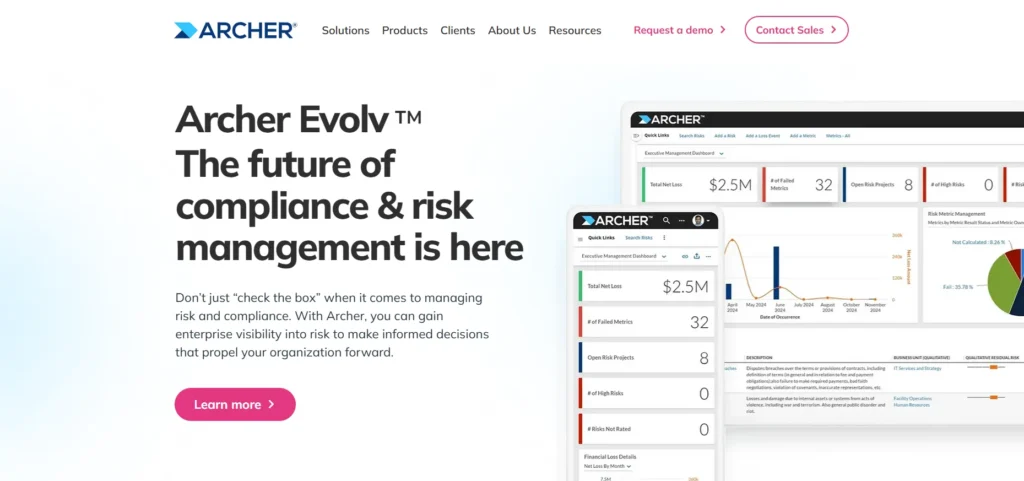
Archer Third Party Risk Management is a powerful platform that provides comprehensive oversight of third-party relationships.
It helps organisations assess risk throughout the vendor lifecycle-from onboarding to offboarding-by streamlining risk assessments, automating workflows, and centralising data. The solution enables businesses to categorise vendors based on criticality, track performance, and monitor compliance with regulatory standards. Integration with internal systems further improves visibility and accountability.
Archer’s configurable dashboards and reporting tools offer actionable insights, making it easier to manage vendor-related threats. It’s especially beneficial for large enterprises looking for a mature, scalable, and integrated TPRM solution.
Features:
- Centralised third-party risk repository
- Customisable risk assessments
- Workflow automation for onboarding
- Risk scoring and segmentation
- Integration with GRC modules
- Regulatory compliance templates
Pros:
- Highly configurable for enterprise use
- Strong reporting and analytics tools
- Seamless integration across risk functions
- Suitable for complex compliance environments
Cons:
- Steep learning curve for new users
- Higher cost for small to mid-sized businesses
2. Prevalent

Prevalent delivers a full-spectrum TPRM solution that simplifies third-party risk assessment, monitoring, and remediation. Its automation tools reduce the burden of manual vendor vetting, while its built-in templates support various industry regulations such as GDPR, HIPAA, and ISO.
Prevalent provides detailed risk scoring, contract management, and real-time threat intelligence to ensure effective risk mitigation. It also supports continuous monitoring of cyber, financial, and reputational risks.
The platform is highly scalable and suited for enterprises with a large vendor ecosystem. Its centralised dashboard, reporting capabilities, and integration support make it a preferred choice for streamlining third-party oversight.
Features:
- Automated vendor assessments
- Third-party risk scoring
- Continuous monitoring across risk domains
- Contract and document management
- Compliance tracking (GDPR, ISO, etc.)
- Threat intelligence integration
Pros:
- Intuitive and user-friendly interface
- Great pre-built templates and frameworks
- Efficient assessment sharing with vendors
- Broad regulatory compliance support
Cons:
- Reporting customisation can be limited
- Can be resource-intensive for initial setup
3. OneTrust Vendor Risk Management

OneTrust’s Vendor Risk Management module is part of its broader trust intelligence platform, helping businesses manage third-party risks across privacy, security, ethics, and ESG. It automates risk assessments using pre-built templates and integrates with vendor questionnaires and performance metrics.
The platform centralises vendor inventories and streamlines due diligence with built-in workflows and evidence collection. It also features continuous monitoring, contract lifecycle management, and integration with procurement tools.
OneTrust’s scalability, user-friendly interface, and deep regulatory support make it suitable for organisations aiming to maintain compliance while managing diverse vendor relationships across multiple regions and risk domains.
Features:
- Automated risk questionnaires
- Centralised vendor inventory
- ESG and privacy compliance tools
- Evidence collection and audit trails
- Real-time risk monitoring
- Procurement and IT tool integration
Pros:
- Strong focus on privacy and ESG
- User-friendly and visually clear dashboards
- Scalable across departments and regions
- Excellent support and documentation
Cons:
- Can be expensive at scale
- Steep configuration process for first-time users
4. BitSight
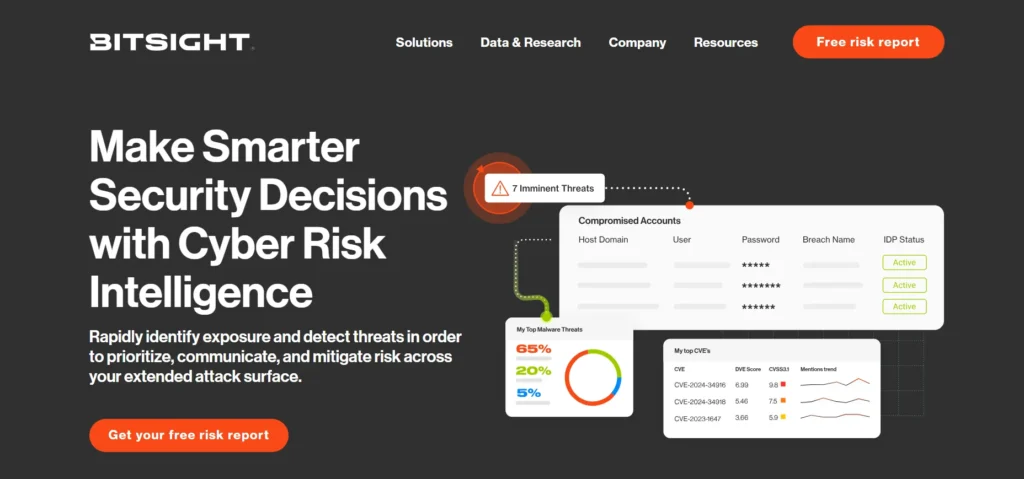
BitSight is a leading cybersecurity ratings platform that assesses the security posture of third parties using objective, external data. It provides continuous monitoring of vendors, offering real-time insights into risk exposure, vulnerabilities, and data breaches.
BitSight simplifies the evaluation process by translating technical security metrics into digestible risk ratings that guide vendor selection and contract negotiations. Its benchmarking and alerting tools help prioritise vendors needing remediation.
The platform also enables performance comparisons across industries. BitSight is ideal for organisations that require a reliable, data-driven approach to evaluate third-party cyber risk and ensure resilience in their supply chain.
Features:
- Continuous external risk monitoring
- Security performance ratings
- Peer benchmarking and comparisons
- Alerting for score changes
- Threat detection and exposure analysis
- Data-driven scorecard system
Pros:
- Objective, real-time risk evaluations
- Great for non-intrusive vendor monitoring
- Easy-to-understand rating metrics
- Enhances cyber risk transparency
Cons:
- Limited insights into internal vendor controls
- Lacks detailed remediation management features
Suggested Read: Customer Engagement Platforms
5. ProcessUnity Vendor Risk Management
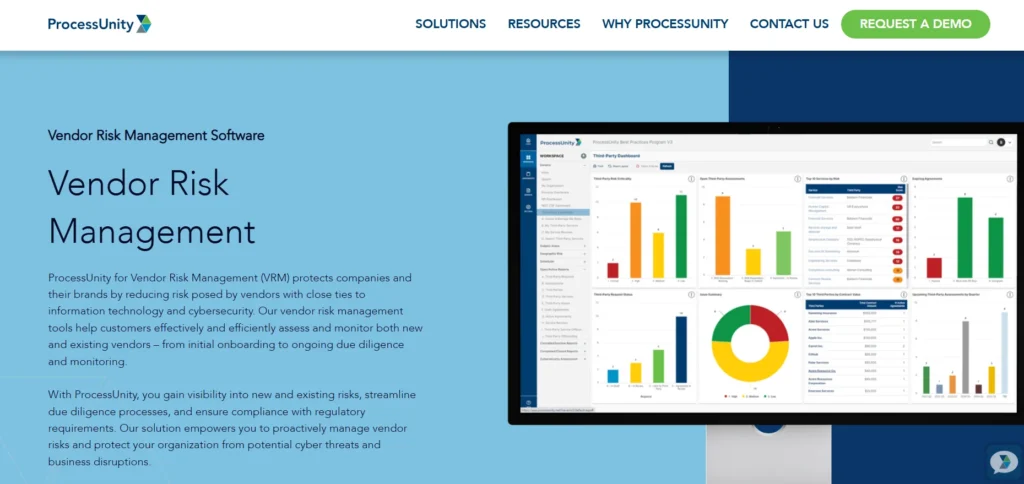
ProcessUnity’s Vendor Risk Management solution offers an end-to-end framework for identifying, assessing, mitigating, and monitoring third-party risks. Its centralised vendor directory and customisable risk assessments help standardise due diligence across the vendor lifecycle.
The platform automates onboarding, risk scoring, document management, and performance tracking. Pre-built templates and workflows enhance compliance with industry standards like NIST, ISO, and FFIEC.
ProcessUnity’s intuitive UI, detailed reporting, and integrations with procurement systems make it easy to scale and tailor to industry-specific needs. It’s particularly effective for regulated industries seeking to establish a structured and defensible third-party risk management program.
Features:
- Risk tiering and scoring
- Vendor onboarding automation
- Due diligence and document tracking
- Custom workflow builder
- Audit-ready reporting tools
- Standards-aligned assessment templates
Pros:
- Highly flexible and scalable
- Quick deployment with low-code options
- Excellent compliance alignment
- Responsive customer support
Cons:
- Interface feels dated in parts
- Vendor collaboration tools could be better
6. RiskRecon by Mastercard
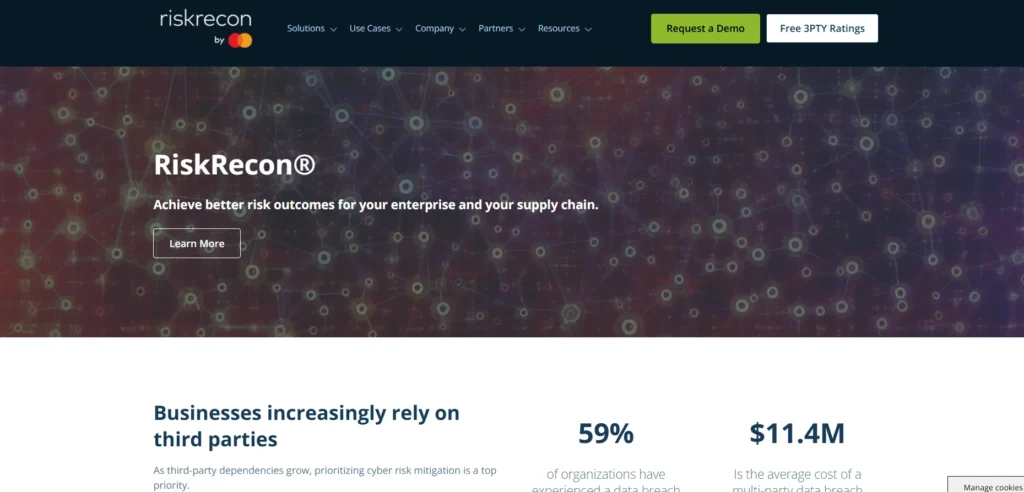
RiskRecon offers an innovative approach to TPRM by providing objective, data-driven insights into third-party cybersecurity health. It continuously monitors vendors by evaluating publicly observable information, assigning a security rating based on industry benchmarks.
Organisations can customise risk tolerances and receive alerts when vendor risk exceeds thresholds. RiskRecon’s analytics dashboard allows for granular assessment of vendors’ IT infrastructure, application security, and system configurations.
It also enables collaboration with vendors to drive improvements. With minimal internal effort required, RiskRecon is a valuable tool for security teams that need accurate, automated vendor assessments without the need for intrusive data requests.
Features:
- Non-intrusive, data-based security ratings
- Customisable risk thresholds
- Domain-specific risk categories
- Public data scanning and analysis
- Executive risk dashboards
- Third-party collaboration tools
Pros:
- Lightweight and low-maintenance
- Fully automated security monitoring
- No questionnaires required
- Great benchmarking tools
Cons:
- Doesn’t assess internal security controls
- Limited beyond cybersecurity risk scope
7. CyberGRX
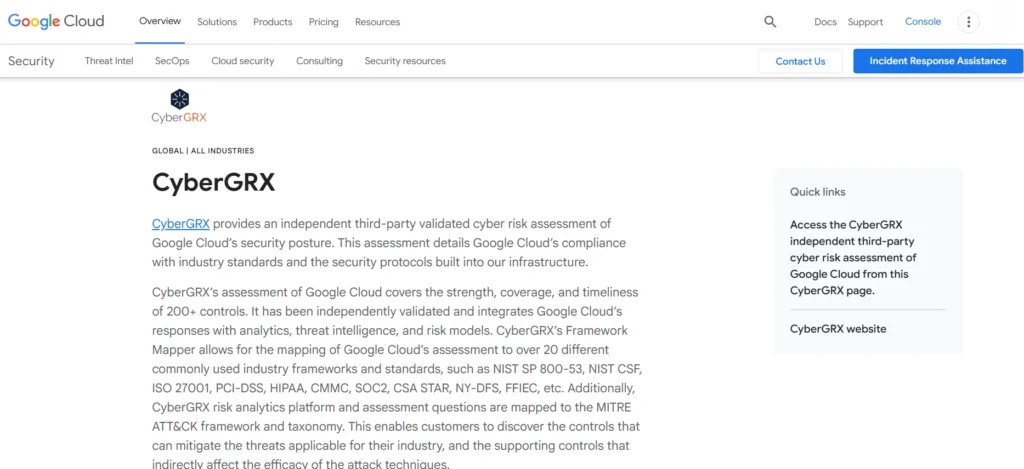
CyberGRX revolutionises third-party risk management with its dynamic, data-rich platform designed for scalability and collaboration. It provides standardised risk assessments backed by real-world threat intelligence and predictive analytics.
The exchange-based model allows vendors to share assessments with multiple clients, significantly reducing redundancy. CyberGRX includes risk tiering, inherent and residual risk scoring, and remediation recommendations. Its interactive dashboards and flexible reporting tools support informed decision-making.
Ideal for businesses managing hundreds of vendors, CyberGRX streamlines workflows and enables proactive risk management. It is especially valuable for organisations looking to adopt a shared assessment model and improve transparency across their vendor network.
Features:
- Shared vendor assessment exchange
- Predictive risk analytics
- Risk tiering and prioritisation
- Threat intelligence integration
- Remediation planning tools
- Inherent and residual risk scoring
Pros:
- Reduces vendor assessment fatigue
- Encourages collaboration and transparency
- Scalable across large ecosystems
- Fast access to shared risk data
Cons:
- Relies on vendors keeping data current
- UI can feel complex for smaller teams
8. Venminder

Venminder specialises in third-party risk management with an emphasis on vendor due diligence, document collection, and compliance support. The platform provides pre-built, expert-reviewed risk assessments for various vendor types and regulatory requirements, saving organisations time and resources.
Venminder enables centralised management of contracts, SLAs, and risk scores, while its customizable workflows and alerts ensure that risk mitigation processes remain on track.
The platform also includes tools for business continuity, cybersecurity, and financial health monitoring. It’s particularly favored by financial institutions and regulated industries that require granular oversight, robust documentation, and alignment with compliance standards like FFIEC and OCC.
Features:
- Pre-built due diligence tools
- Expert-reviewed vendor risk assessments
- Financial and cyber risk evaluation
- SLA and contract tracking
- Centralised document repository
- Vendor performance management
Pros:
- Tailored for regulated industries
- Strong compliance and audit support
- Quick access to expert assessments
- Easy-to-use platform for small teams
Cons:
- Less flexible for custom workflows
- Limited outside of financial and healthcare sectors
9. LogicGate Risk Cloud
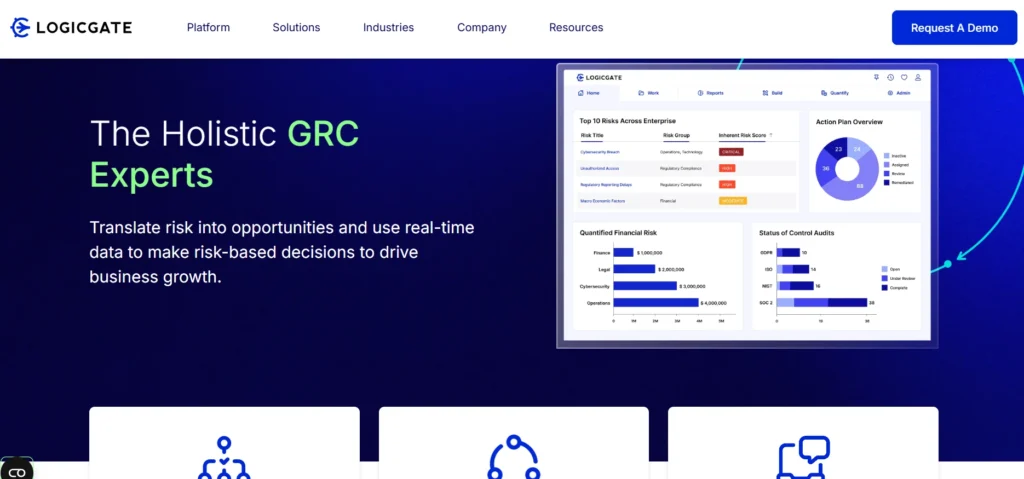
LogicGate’s Risk Cloud platform offers a highly customizable, no-code TPRM solution that empowers organisations to design and automate their own workflows. With modular apps for onboarding, risk assessment, issue tracking, and vendor reviews, Risk Cloud adapts to varying business needs.
It supports risk quantification, third-party inventories, and integrates with existing procurement and GRC tools. The visual workflow builder and user-friendly dashboards make it easy to scale and optimise TPRM processes.
LogicGate is especially useful for teams seeking flexibility without sacrificing governance. It’s a strong choice for companies wanting to tailor their risk framework while maintaining agility and compliance.
Features:
- No-code workflow builder
- Risk scoring and analytics
- Third-party issue management
- Modular app library
- API integrations with GRC/IT tools
- Dynamic reporting dashboards
Pros:
- Extreme flexibility in setup
- Great for cross-team collaboration
- Customisable workflows for any use case
- Clean, modern interface
Cons:
- Requires time to design workflows
- May lack depth in out-of-box templates
10. MetricStream Third-Party Risk Management
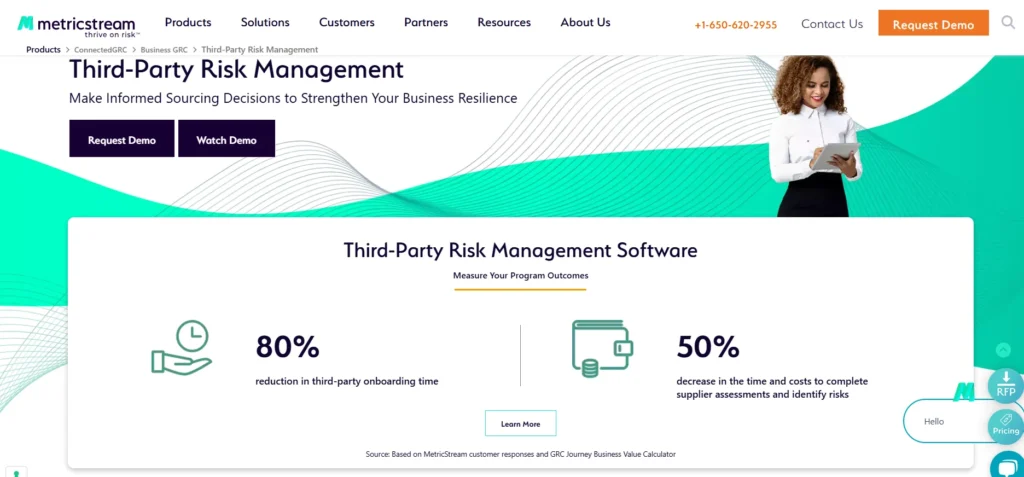
MetricStream provides a robust TPRM platform that enables organisations to manage the full lifecycle of third-party risks. It supports onboarding, due diligence, ongoing monitoring, and issue resolution with integrated workflows and analytics.
The platform includes pre-defined templates for regulatory compliance, such as GDPR, HIPAA, and SOX. MetricStream’s real-time dashboards track vendor performance and risk levels, helping businesses make data-driven decisions. It also facilitates collaboration with vendors through shared portals.
Designed for large enterprises, MetricStream excels in centralising and scaling TPRM processes across global supply chains. Its extensive capabilities make it ideal for risk-conscious industries with complex regulatory requirements.
Features:
- Centralised third-party portal
- Risk intelligence integration
- Lifecycle management (onboarding to exit)
- Policy and compliance tracking
- Issue resolution workflows
- Real-time analytics and dashboards
Pros:
- Comprehensive feature set for enterprises
- Excellent audit and reporting capabilities
- Highly secure and scalable
- Strong regulatory framework alignment
Cons:
- Complex UI may deter casual users
- High implementation and training time
Ending Thoughts
Effective Third-Party Risk Management (TPRM) is essential for organisations aiming to maintain operational resilience, regulatory compliance, and data security in today’s interconnected business landscape. The right TPRM tool empowers companies to identify, assess, and mitigate vendor-related risks with accuracy and efficiency. By leveraging automation, real-time monitoring, and comprehensive reporting, these platforms help businesses stay ahead of potential disruptions and compliance violations.
Choosing a TPRM solution that aligns with your organisation’s size, industry, and risk appetite is crucial. Whether it’s for managing cybersecurity threats, financial instability, or reputational damage, a robust TPRM tool provides the visibility and control needed to build trusted third-party relationships. Ultimately, strong third-party risk practices contribute to long-term business sustainability and governance excellence.
FAQs
Why is third-party risk management important?
It protects businesses from financial, operational, and reputational damage caused by third-party failures, data breaches, or regulatory non-compliance.
What key features should I look for in a TPRM tool?
Look for automated risk assessments, real-time monitoring, compliance tracking, customisable dashboards, and integration with existing systems.
Can TPRM tools help with regulatory compliance?
Yes, they assist in meeting regulations such as GDPR, HIPAA, SOX, and others by documenting and managing third-party risks.
Are TPRM tools suitable for small businesses?
Many TPRM platforms offer scalable solutions, making them suitable for businesses of all sizes, including startups and SMEs.
